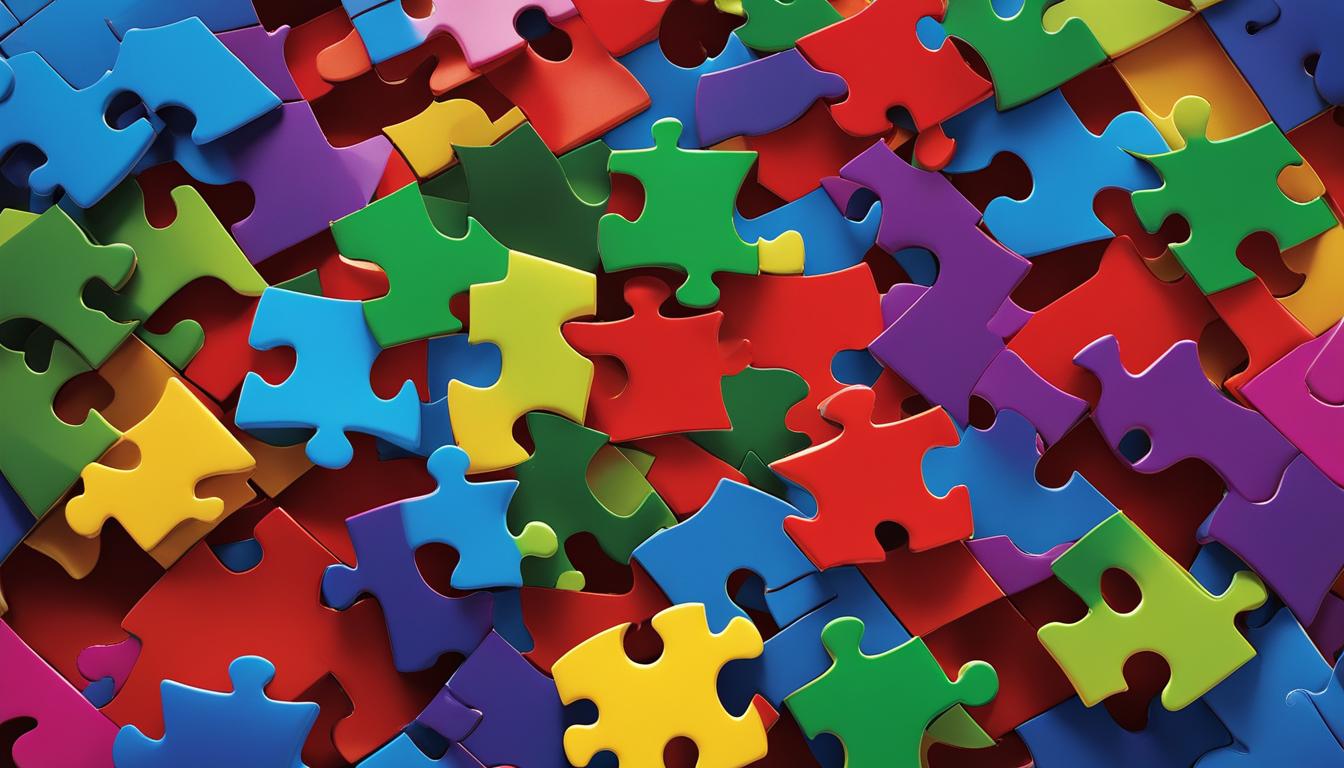Did you know that the inkblot personality test, also known as the Rorschach test, was created by Swiss psychologist Hermann Rorschach in 1921? Originally designed for diagnosing schizophrenia, this psychological evaluation has since become a popular method for gaining insight into personality traits and emotional health. By examining how people interpret inkblot images, the test can offer valuable information about their thought patterns, personality traits, and emotional state.
Key Takeaways:
- The inkblot personality test, or Rorschach test, was developed by Hermann Rorschach in 1921.
- Initially used for diagnosing schizophrenia, the test now assesses personality traits and emotional well-being.
- Participants’ interpretations of inkblot images provide insights into their thought processes and personality characteristics.
- The test is widely used in psychology for personality evaluation and psychological assessment.
- By understanding the inkblot test, individuals can gain a deeper understanding of themselves and enhance their self-awareness.
Understanding the Inkblot Test
The inkblot test is a widely known projective psychological assessment that utilizes ambiguous inkblot images to gain insights into an individual’s thought processes, personality traits, and emotional functioning.
This visual stimuli test consists of ten symmetrical inkblots, some in black and red, and others in black only. During the test, participants are presented with each inkblot and asked to describe what they see. There are no right or wrong answers. The clinician records the responses verbatim without any modifications.
The scoring system for the inkblot test is complex and involves the categorization of participant responses based on various characteristics. These characteristics include human, animal, inanimate objects, shading, and color. By analyzing these categories, psychologists can gain valuable insights into an individual’s perception, cognition, and emotional state. The inkblot test can be used to assess personality traits and emotional functioning.
By examining an individual’s interpretations of the inkblot images, psychologists can uncover subconscious thoughts and emotions, providing a deeper understanding of the person being assessed. This projective personality test developed in 1921 by Hermann Rorschach continues to be a valuable tool in psychological testing and assessment.
Sample Inkblot Responses
Participant’s response:
“I see a butterfly with its wings spread, surrounded by flowers.”
Participant’s response:
“I see a scary monster with sharp teeth and horns.”
These examples demonstrate the variety of responses individuals can provide when interpreting inkblot images. The inkblot test allows for subjective interpretation, showcasing the diversity of human perception and cognition.
Scoring System for the Inkblot Test
The inkblot test incorporates a comprehensive scoring system to analyze participant responses. The scoring system involves categorizing responses based on various characteristics and factors such as human figures, animal depictions, shading, color, and inanimate objects.
Here is an example of a scoring system used for inkblot interpretation:
| Category | Description |
|---|---|
| Human | Responses related to human figures |
| Animal | Responses related to animal depictions |
| Shading | Responses related to shading or texture |
| Color | Responses related to color perception |
| Inanimate | Responses related to inanimate objects |
The scoring system allows psychologists to quantify and analyze the participant’s responses, providing objective data that contributes to a comprehensive evaluation.
The inkblot test, with its unique approach to psychological testing, offers valuable insights into an individual’s thought processes, perception, and emotional functioning. By leveraging the interpretive power of inkblots, psychologists can gain a deeper understanding of personality traits and psychological well-being.
The History of the Inkblot Test
The inkblot test, also known as the Rorschach test, has a rich history dating back to its development by Swiss psychiatrist Hermann Rorschach in 1921. Inspired by the teachings of Sigmund Freud, Rorschach devised this psychological test to measure thought disorder and explore the realms of unconscious thoughts.
The original test consists of ten inkblot images, carefully designed to trigger a variety of responses from individuals. Over the years, the Rorschach test has gained recognition and acceptance, becoming a widely used projective measure in the field of psychology.
The International Society of the Rorschach and Projective Methods continues to acknowledge the significance of the Rorschach Test in evaluating personality characteristics and emotional functioning. This test, based on the interpretation of inkblot images, offers valuable insights into an individual’s psyche and sheds light on their unique personality traits.

This image represents a visual representation of the inkblots used in the Rorschach ink blot test, developed in 1921 by Hermann Rorschach.
The Original Test and its Purpose
The Rorschach Test was created as a means to understand thought processes and reveal unconscious thoughts. By presenting subjects with ambiguous inkblot images, the test aims to tap into their psychological landscape, uncovering aspects of their personality characteristics and emotional well-being.
Since its inception, the Rorschach Test has become an integral part of psychological assessments, providing valuable information about cognition and emotional functioning. It offers psychologists a unique way to measure an individual’s thought disorder and gain insights into their inner world.
Continued Recognition and Application
The inkblot test developed by Hermann Rorschach has stood the test of time and remains an essential tool for psychological evaluation. Despite the criticisms and controversies surrounding the test, its value in assessing personality characteristics and emotional functioning cannot be underestimated.
Psychologists and mental health professionals continue to utilize the inkblot test as part of comprehensive assessments, offering patients a deeper understanding of their psychological state. The test’s ability to reveal individual thought patterns, motivations, and personality structure allows for a more holistic approach to treatment and intervention.
| Key Points | Advantages |
|---|---|
| Provides insights into personality characteristics and emotional functioning | Allows individuals to project their thoughts and emotions onto the inkblot images |
| Based on a series of ten symmetrical and ambiguous inkblot images | A valuable tool for psychologists to gain insights into thought processes and motivations |
| Recognized by the International Society of the Rorschach and Projective Methods | Offers a unique perspective on an individual’s psychological well-being |
| Continues to be widely used in psychological assessments | Provides data to evaluate cognitive and emotional variables |
The inkblot test, developed in 1921 by Hermann Rorschach, has had a lasting impact on the field of psychology. Its application in assessing personality characteristics and emotional functioning has provided valuable insights into the intricacies of the human mind.
How the Inkblot Test Works
The inkblot test is a projective measure that aims to uncover unconscious thoughts and reveal aspects of an individual’s personality. Through the administration of inkblots, we can examine a person’s personality functioning and gain insights into various aspects of their true personality. By presenting participants with a series of ambiguous inkblot patterns, we can tap into their unconscious thoughts and motivations.
During the test, individuals are asked to describe what they see in the inkblot images. The responses they provide offer valuable information about their cognition and personality variables, such as motivations and inkblot content. While there are no right or wrong answers, the interpretations of the responses are based on established scoring systems that categorize and analyze the participant’s descriptions.
The scoring system for the inkblot test involves examining different aspects of personality and thought processes. It takes into account various factors, such as the individual’s interpretations of inkblot patterns, color responses, shading, and inkblot content. This comprehensive approach allows us to gain a deeper understanding of an individual’s personality functioning.
It’s important to note that the inkblot test does not provide a definitive assessment of a person’s true personality. Instead, it offers valuable insights into different aspects of their personality. By combining the results of the inkblot test with other psychological assessments and evaluations, we can create a more comprehensive picture of an individual’s personality traits and emotional well-being.
| Aspect | Description |
|---|---|
| Projective Measure | The inkblot test is a projective measure that allows individuals to project their thoughts, emotions, and personality traits onto the ambiguous inkblot images. |
| Unconscious Thoughts | Through the inkblot test, we aim to uncover unconscious thoughts that may not be readily accessible through other assessment methods. |
| Personality Functioning | The test provides insights into an individual’s personality functioning, including their thought processes, emotional responses, and motivations. |
| Examine a Person’s Personality | By analyzing their responses, we can examine different aspects of an individual’s personality and gain a deeper understanding of who they are. |
| Scoring System | The inkblot test uses a scoring system to categorize and interpret the participant’s responses based on various cognitive and personality variables. |
| Cognition and Personality Variables | We analyze the participant’s cognition and personality variables, such as motivations and inkblot content, to gain insights into their thought processes and emotional functioning. |
Through the inkblot test, we can delve into the intricate aspects of an individual’s personality and gain valuable insights into their true self. It is a powerful tool that allows us to explore the depths of the human psyche and better understand the complexities of human behavior.
Applications of the Inkblot Test
The inkblot test has found numerous applications in the field of psychology, offering valuable insights into various aspects of mental health assessment, personality disorders, and self-discovery.
Schizophrenia Diagnosis and Treatment
One significant area of application for the inkblot test is in the assessment and diagnosis of schizophrenia. Schizophrenia patients often exhibit distinct patterns of responses to the inkblot images, allowing psychologists to gain valuable insights into their thought disorder and emotional functioning. These insights can aid in developing more targeted treatment plans and improving the overall quality of life for individuals with schizophrenia.
Personality Disorders and Emotional Well-being
The inkblot test is also widely used in the assessment of personality disorders. By analyzing the participant’s responses to the inkblot images, psychologists can gain insights into their personality characteristics and emotional functioning. This information is invaluable for diagnosing, treating, and managing personality disorders, enabling psychologists to tailor interventions and therapies to meet the unique needs of each individual.
Self-Reflection and Personality Quizzes
Beyond clinical applications, the inkblot test’s visual stimuli and thought-provoking nature make it popular for personality assessments and online personality quizzes. Engaging in these assessments allows individuals to gain insights into their own personality characteristics, emotional well-being, and overall self-awareness. The inkblot test provides a unique opportunity for self-reflection and personal growth.

Image: Inkblot image used in the assessment of schizophrenia patients.
Uncovering Hidden Thoughts and Emotions
The inkblot test is renowned for its ability to tap into unconscious thoughts and emotions. It provides a safe and non-intrusive way for individuals to explore their innermost feelings and reveal aspects of themselves they may not be aware of. By delving into the depths of the human psyche, the inkblot test allows psychologists and individuals alike to gain a deeper understanding of the complexities of the mind.
So whether it’s assisting in diagnosing mental illnesses, uncovering hidden personality traits, or encouraging self-reflection, the inkblot test continues to be a valuable tool in psychology, contributing to a more comprehensive understanding of the human mind and facilitating personal growth.
Limitations and Controversies of the Inkblot Test
While the inkblot test is widely used and recognized in the field of psychology, it is not without its criticisms and skepticism. Some argue that the test heavily relies on self-reported data, which can be subjective and prone to misrepresentation or misinterpretation. The individuality of each person is also overlooked, as the test assumes that people with certain mental health diagnoses have overlapping symptoms. Furthermore, predicting behaviors based solely on the results of the inkblot test can be problematic, considering the complex nature of the human brain and the multitude of factors that influence behavior.
Despite these concerns, the inkblot test can still provide valuable insights into emotional functioning, personality traits, and specific mental illnesses when used alongside other diagnostic tools. It is important to recognize the limitations of the test and approach the interpretation of its results with caution.
Limitations and Criticisms of the Inkblot Test
| Limitations | Criticisms |
|---|---|
| Reliance on self-reported data | “The test is subjective and open to misinterpretation.” |
| Overlooking individuality | “The test assumes that people with certain mental health diagnoses have overlapping symptoms, disregarding the unique experiences of each individual.” |
| Limitations in predicting behaviors | “Attempting to predict complex behaviors based solely on inkblot interpretations may not always be accurate.” |
It is important to consider these limitations and controversies when using the inkblot test as a psychological assessment tool. Supplementing the test with other measures and taking into account the individual’s unique circumstances can lead to a more comprehensive understanding of their psychological well-being.

Inkblot Interpretation: What Do You See?
The interpretation of inkblots in the inkblot test is a crucial step in understanding an individual’s thought processes and personality characteristics. Each participant’s responses are analyzed based on a set of predefined variables, such as color responses, shading, and content.
The inkblot interpretation involves identifying patterns and themes in the participant’s responses to gain insights into their emotional functioning, personality traits, and psychological state. By examining the unique associations made by individuals, we can uncover hidden aspects of their subconscious mind.
The analysis of inkblots can provide valuable data for psychologists and mental health professionals to assess and evaluate a person’s psychological well-being. It allows us to delve into the depths of the human mind, uncovering deep-seated emotions, fears, and desires.
“The inkblot test acts like a mirror, reflecting the inner landscape of an individual’s mind,” says Dr. Sarah Watson, a renowned psychologist. “Through the interpretation of inkblots, we gain a window into their unique psychological makeup.”
Color Responses
Color responses play a significant role in inkblot interpretation. The colors chosen by participants can reveal clues about their emotional state and psychological tendencies. For example, vibrant colors may indicate a positive emotional disposition, while darker colors may suggest feelings of sadness or anxiety.
By examining the consistency of color responses throughout the test, we can gain insights into an individual’s overall emotional functioning and stability. Patterns and trends in color choices can help us understand how individuals perceive the world around them and how their emotions influence their experiences.
Uncovering the Unconscious
The inkblot test goes beyond surface-level analysis and taps into the realm of the unconscious mind. The abstract nature of the inkblots allows individuals to project their thoughts, feelings, and desires onto the images, providing a unique glimpse into the depths of their psyche.
Inkblot interpretation involves looking for recurring symbols or themes in a person’s responses. It enables us to identify common associations and underlying psychological processes that may be influencing their behavior, beliefs, and decisions.
Personalized Insights
Each individual’s inkblot responses are highly personal, offering a window into their unique thought patterns and psychological makeup. The interpretation process considers a wide range of factors, including the specific details mentioned by the individual, the emotions conveyed, and the overall narrative that emerges from their responses.
By analyzing the inkblot test results, psychologists and mental health professionals can gain valuable insights into a person’s personality traits, emotional functioning, and psychological well-being. This knowledge can inform personalized treatment plans, guide therapy sessions, and provide individuals with a deeper understanding of themselves.
The Power of Inkblot Analysis
Through inkblot analysis, we are equipped with a powerful tool to explore the complexities of the human mind. The interpretation of inkblots allows us to tap into the depths of an individual’s psyche, uncover hidden aspects of their thought processes, and gain insights into their unique personality characteristics and emotional state.
By embracing the subjective nature of the inkblot test and approaching it with curiosity and empathy, we can unlock a wealth of knowledge about human psychology. The inkblot test offers a creative and thought-provoking approach to psychological assessment, providing anyone seeking self-discovery or seeking answers with a fascinating exploration of their own mind.

The Importance of Inkblot Assessment
Inkblot assessment, such as the Rorschach test, plays a vital role in psychological evaluation and personality assessment. It allows us to gather valuable data about an individual’s personality structure, emotional functioning, and cognitive processes. The inkblot analysis provides insights into thought patterns, motivations, and overall psychological well-being. Despite some critics questioning the validity of the Rorschach test, it continues to be widely used and is considered a valuable tool in psychological assessment and understanding the complexities of human personality.
Understanding Personality Structure
Personality evaluation is a fundamental aspect of psychological assessment. Through inkblot assessment, we can gain a deeper understanding of an individual’s unique personality structure. The Rorschach test allows us to explore the different dimensions of personality, such as introversion vs. extroversion, conscientiousness, openness to experience, and emotional stability. By analyzing a person’s responses to inkblot images, we can identify patterns that reveal important insights into their personality traits.
Assessing Emotional Functioning
Emotional functioning is another crucial aspect of psychological assessment. The Rorschach test provides a window into an individual’s emotional landscape by evaluating their emotional responses to the inkblot images. By analyzing the intensity, range, and appropriateness of emotional expressions, we can assess emotional functioning, identify potential emotional disturbances, and tailor appropriate interventions.
Uncovering Cognitive Processes
Cognitive processes are key elements of psychological assessment. The Rorschach test offers a unique opportunity to gain insights into an individual’s cognitive functioning. By examining the way they perceive and interpret the inkblot images, we can gather information about their cognitive processes, such as problem-solving abilities, attention to detail, and cognitive biases. These insights help us understand how individuals process information and make sense of their environment.
| Benefits of Inkblot Assessment | Key Takeaways |
|---|---|
| Provides valuable data about personality structure, emotional functioning, and cognitive processes | Gain insights into an individual’s unique personality traits |
| Offers a window into emotional functioning and assists in identifying emotional disturbances | Assess emotional well-being and tailor interventions accordingly |
| Helps uncover cognitive processes, problem-solving abilities, and cognitive biases | Understand how individuals process information and perceive their environment |
Despite ongoing debates about the validity of the Rorschach test, it remains a valuable tool in psychological assessment. When used alongside other assessment methods, the inkblot test contributes to a comprehensive understanding of an individual’s psychological well-being. By tapping into the unconscious and revealing aspects of personality and emotional functioning, inkblot assessment supports effective treatment planning, intervention strategies, and personal growth.

Advantages of the Inkblot Test
The inkblot test offers several advantages in psychological testing and assessment. As a projective test, it allows individuals to project their thoughts, emotions, and personality traits onto the ambiguous inkblot images. The test was developed in 1921 by Hermann Rorschach and has since become widely used in psychology.
The inkblot test provides insights into various aspects of a person’s psychological makeup, including their personality structure, emotional functioning, and thought processes. By examining their responses to the inkblot cards, psychologists can gain a deeper understanding of an individual’s psychological state.
This projective psychological test is known as the Rorschach test, named after its creator Hermann Rorschach. It offers a unique perspective on an individual’s personality traits and emotional well-being.
“The inkblot test allows us to delve into the hidden recesses of the human mind, uncovering subconscious thoughts and motivations that may not be apparent through other forms of psychological assessment.”
By analyzing the inkblot responses, psychologists can gain insights into an individual’s personality structure and identify underlying patterns and themes. This information can be valuable in helping to understand an individual’s cognitive processes, emotions, and motivations.
The use of inkblot cards in the test provides a standardized set of stimuli, ensuring consistent application across different individuals and allowing for meaningful comparisons and analysis.
In conclusion, the inkblot test offers a unique and valuable approach to psychological testing and assessment. Its projective nature allows individuals to express their inner thoughts and emotions, providing insights into their personality structure and psychological well-being.

Understanding the Inkblot Test Results
The inkblot test results are obtained through a scoring system and the interpretation of inkblot responses. The scoring system involves categorizing and analyzing the participant’s responses based on various personality traits, cognitive variables, and emotional functioning.
During the inkblot interpretation, data about the participant’s cognition and personality variables are analyzed, providing valuable insights into their personality structure, emotional well-being, and the presence of any personality disorders. This analysis of inkblot responses can reveal significant information about an individual’s psychological state and help inform treatment and intervention strategies.
Results showed that the inkblot test, when combined with the appropriate scoring system and inkblot analysis, is a powerful tool for understanding and evaluating an individual’s personality traits and cognition and personality variables. This information can be crucial in determining the best course of action for therapy, counseling, or further psychological assessment.
Example Rorschach Protocols:
| Rorschach Protocol | Personality Traits | Emotional Functioning | Cognitive Variables |
|---|---|---|---|
| Protocol A | Introverted, detail-oriented, cautious | Stable emotional state with minor anxiety | Concrete thinking, rule-oriented |
| Protocol B | Extroverted, imaginative, intuitive | Emotionally expressive with high optimism | Flexible thinking, creative problem-solving |
| Protocol C | Reserved, skeptical, systematic | Emotionally guarded with moderate self-criticism | Analytical thinking, attention to detail |

The results obtained from the inkblot test provide psychologists and mental health professionals with valuable data about an individual’s cognition and personality variables, allowing for a deeper understanding of their psychological well-being. This information can contribute to the development of personalized treatment plans and therapeutic approaches.
Application of the Rorschach Test in Different Fields
The Rorschach test, as a form of the inkblot test, has found applications in various fields. It is not limited to the realm of psychology but extends its usefulness to other domains where assessing personality and emotional well-being is crucial.
Mental Health Assessment
In the field of mental health, the Rorschach test has been widely used to assess and diagnose conditions such as schizophrenia. By analyzing an individual’s responses to the inkblot images, professionals can gain insights into thought disorder and emotional functioning, aiding in accurate diagnosis and treatment planning.
Adoption Process
In the adoption process, prospective parents are often encouraged to undergo psychological evaluations to assess their suitability and provide valuable information to make appropriate matches with children. The Rorschach test is frequently included in these evaluations, helping to assess an individual’s psychological well-being and potential as an adoptive parent.
Creativity Assessment
Beyond mental health assessment, the inkblot test has also been utilized in examining creativity. It can help measure intelligence and inspire artistic expression. By studying how individuals interpret and respond to the inkblot images, psychologists gain insights into their cognitive abilities and creative thinking patterns.

As the Rorschach test demonstrates its versatility, it continues to offer valuable information in various fields, transcending the boundaries of traditional psychology. From mental health assessments and adoption processes to creativity evaluations, the inkblot test remains an essential tool in understanding the complexities of human personality and emotional well-being.
Conclusion
The inkblot personality test, also known as the Rorschach test, offers valuable insights into an individual’s personality traits, emotional functioning, and cognitive processes. Developed in 1921 by Hermann Rorschach, this projective measure has become widely used in psychology for assessing personality and psychological well-being. Despite the ongoing limitations and controversies surrounding the inkblot test, it remains a valuable tool in psychological assessment and understanding the complexities of human personality.
Whether administered in clinical settings or used in online personality quizzes, the inkblot test provides individuals with an opportunity to gain deeper insights into their true selves and enhance their self-awareness. By analyzing a person’s responses to ambiguous inkblot images, the test can reveal important aspects of their thought processes, motivations, and emotional functioning.
It is essential to acknowledge that the inkblot test is just one tool in a comprehensive psychological assessment. While it can provide valuable information about an individual, it should be used in conjunction with other tests and assessments to form a well-rounded evaluation of personality and psychological well-being.
In conclusion, the inkblot personality test offers a unique approach to understanding oneself and assessing psychological traits. By tapping into the individual’s inner thoughts and perceptions, this test provides valuable insights that contribute to personal growth, self-awareness, and an enhanced understanding of human behavior.
FAQ
What is the inkblot personality test?
The inkblot personality test, also known as the Rorschach test, is a psychological assessment that involves the interpretation of ambiguous inkblot images to gain insights into an individual’s thought processes, personality characteristics, and emotional functioning.
How does the inkblot test work?
The inkblot test is a projective measure where participants are shown a series of inkblot images and asked to describe what they see. There are no right or wrong answers, and the clinician records the responses verbatim for later analysis and interpretation.
What is the history of the inkblot test?
The inkblot test was developed by Swiss psychiatrist Hermann Rorschach in 1921. Rorschach aimed to measure thought disorder and uncover unconscious thoughts using inkblots. The test has since become widely recognized and used in the field of psychology.
What are the applications of the inkblot test?
The inkblot test has various applications in the assessment and diagnosis of mental health conditions, such as schizophrenia and personality disorders. It is also used in personality assessments and online quizzes to provide individuals with insights into their own personality characteristics.
What are the limitations and controversies of the inkblot test?
Critics argue that the inkblot test relies heavily on self-reported data, which can be subject to misrepresentation or misinterpretation. Additionally, the test assumes that people with certain mental health diagnoses have overlapping symptoms, overlooking the individuality of each person.
How is the inkblot test interpreted?
The inkblot test is interpreted by analyzing the participant’s responses based on various personality traits, cognitive variables, and emotional functioning. The analysis focuses on identifying patterns and themes to gain insights into the person’s psychological state.
Why is inkblot assessment important?
Inkblot assessment provides valuable data about an individual’s personality structure, emotional functioning, and cognitive processes. It contributes to psychological evaluation and understanding the complexities of human personality.
What are the advantages of the inkblot test?
The inkblot test allows individuals to project their thoughts, emotions, and personality traits onto ambiguous inkblot images. It provides insights into various aspects of a person’s psychological makeup, including their personality structure, emotional functioning, and thought processes.
How are the inkblot test results interpreted?
The inkblot test results are obtained through a scoring system and the interpretation of inkblot responses. The analysis involves categorizing and analyzing the participant’s responses based on various personality traits, cognitive variables, and emotional functioning.
What are the different fields where the inkblot test is applied?
The inkblot test has been used in the assessment and diagnosis of mental health conditions, such as schizophrenia. It is also utilized in the adoption process, creativity assessment, and psychological evaluation where assessing personality and emotional well-being is important.
What is the significance of the inkblot personality test?
The inkblot personality test plays an important role in psychological evaluation and personality assessment. It provides valuable insights into an individual’s personality traits, emotional functioning, and cognitive processes.
Felicity, our Author, pens in-depth articles and guides that delve into the heart of personal discovery. Her narrative-driven approach weaves together theory, practice, and personal anecdotes, making the journey of self-exploration both relatable and inspiring. Felicity’s contributions help illuminate the path for those seeking a deeper understanding of themselves and their relationships.










